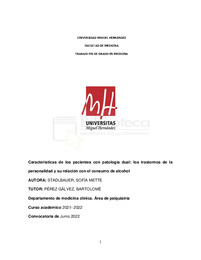Por favor, use este identificador para citar o enlazar este ítem:
https://hdl.handle.net/11000/28573Registro completo de metadatos
| Campo DC | Valor | Lengua/Idioma |
|---|---|---|
| dc.contributor.advisor | Pérez Gálvez, Bartolomé | - |
| dc.contributor.author | Stadlbauer, Sofia Mette | - |
| dc.contributor.other | Departamentos de la UMH::Medicina Clínica | es_ES |
| dc.date.accessioned | 2022-12-07T12:40:57Z | - |
| dc.date.available | 2022-12-07T12:40:57Z | - |
| dc.date.created | 2022-05-10 | - |
| dc.identifier.uri | https://hdl.handle.net/11000/28573 | - |
| dc.description.abstract | Introducción: Los trastornos por consumo de alcohol son una de las principales causas de morbimortalidad y gasto sanitario a nivel mundial. Es muy frecuente su asociación a otras psicopatológicas, en especial a los trastornos de la personalidad (TP). Se postula que esta coexistencia supone una peor respuesta al tratamiento, con mayor número de recaídas y en definitiva peor pronóstico. Este estudio se planteó analizar la asociación existente entre estas patologías, conociendo su prevalencia, las diferencias entre géneros, la severidad y los motivos que dirigen el consumo en estos casos, para así avanzar hacia un nuevo enfoque en el tratamiento de estos pacientes. Material y método: Se planteó un estudio descriptivo transversal, partiendo de una muestra compuesta por 125 pacientes en seguimiento por la Unidad de Alcohol del Hospital Universitario de San Juan de Alicante. Se utilizaron la escala Short Alcohol Dependence Data (SADD), para valorar el grado de dependencia; el Inventory of Drinking Situations-42 (IDS-42), para analizar los motivos de consumo; y la International Personality Disorder Examination (IPDE), para diagnosticar TP. Resultados: La prevalencia total de TP en la muestra fue de 28,8%, con una asociación estadísticamente significativa a las mujeres frente a los varones (41,7% vs 20,8%; X2[1]=6,291; p=,012) y siendo los TP más frecuentes del Cluster B y C. Los pacientes con patología dual tenían una dependencia más severa y eran más propensos a sufrir depresión que los individuos alcohólicos sin TP. Los motivos de consumo asociados a la patología dual tienen como objetivo el afrontamiento de sentimientos negativos. No se encontraron diferencias en el craving de los pacientes con y sin TP. Conclusión: Se encontró una clara asociación de los TP con los trastornos por consumo de alcohol, más evidente en las mujeres, y suponiendo esto una mayor severidad de la dependencia y del grado de psicopatología asociada. Los motivos de consumo parecen el punto de unión entre ambos trastornos, suponiendo una herramienta terapéutica que merece un estudio más profundo en el futuro. | es_ES |
| dc.description.abstract | Introduction: Alcohol consumption disorders are one of the main causes of morbidity, mortality and healthcare costs worldwide. Its association with other psychopathologies is very frequent, especially with personality disorders (PD). It is postulated that this coexistence implies a worse response to treatment, with a greater number of relapses and, ultimately, a worse prognosis. This study aimed to analyze the existing association between these pathologies, knowing their prevalence, differences between genders, severity and the reasons that lead to consumption in these cases, in order to move towards a new approach in the treatment of these patients. Material and method: A cross-sectional descriptive study was proposed, starting from a sample composed of 125 patients in follow-up by the Alcohol Unit of the University Hospital of San Juan de Alicante. The Short Alcohol Dependence Data (SADD) scale was used to assess the degree of dependence; the Inventory of Drinking Situations-42 (IDS-42), to analyze the reasons for consumption; and the International Personality Disorder Examination (IPDE), to diagnose PD. Results: The total prevalence of PD in the sample was 28.8%, with a statistically significant association to the women (41.7% vs. 20.8%; X2[1]=6.291; p=, 012) and being the most frequent PDs from Cluster B and C. Patients with dual pathology had a more severe dependency and were more likely to suffer from depression than alcoholic individuals without PD. The consumption motives associated with dual pathology are aimed at coping with negative feelings. No differences were found in the craving of patients with and without PD. Conclusion: A clear association of PDs with alcohol use disorders was found, more evident in women, and assuming a greater severity of dependence and the degree of associated psychopathology. The reasons for consumption seem to be the point of union between both disorders, beeing a therapeutic tool that deserves a more in-depth study in the future | es_ES |
| dc.format | application/pdf | es_ES |
| dc.format.extent | 26 | es_ES |
| dc.language.iso | spa | es_ES |
| dc.publisher | Universidad Miguel Hernández de Elche | es_ES |
| dc.rights | info:eu-repo/semantics/openAccess | es_ES |
| dc.rights.uri | http://creativecommons.org/licenses/by-nc-nd/4.0/ | * |
| dc.subject | Consumo de alcohol | es_ES |
| dc.subject | Alcoholismo | es_ES |
| dc.subject | Dependencia | es_ES |
| dc.subject | Trastornos de personalidad (TP) | es_ES |
| dc.subject | Patología dual | es_ES |
| dc.subject | Morbimortalidad | es_ES |
| dc.subject | Tratamiento | es_ES |
| dc.subject | Varones | es_ES |
| dc.subject | Mujeres | es_ES |
| dc.subject.other | CDU::6 - Ciencias aplicadas::61 - Medicina | es_ES |
| dc.title | Características de los pacientes con patología dual: los trastornos de la personalidad y su relación con el consumo de alcohol | es_ES |
| dc.type | info:eu-repo/semantics/bachelorThesis | es_ES |

Ver/Abrir:
STADLBAUER, SOFÍA METTE, TFG.pdf
1,18 MB
Adobe PDF
Compartir:
 La licencia se describe como: Atribución-NonComercial-NoDerivada 4.0 Internacional.
La licencia se describe como: Atribución-NonComercial-NoDerivada 4.0 Internacional.
.png)